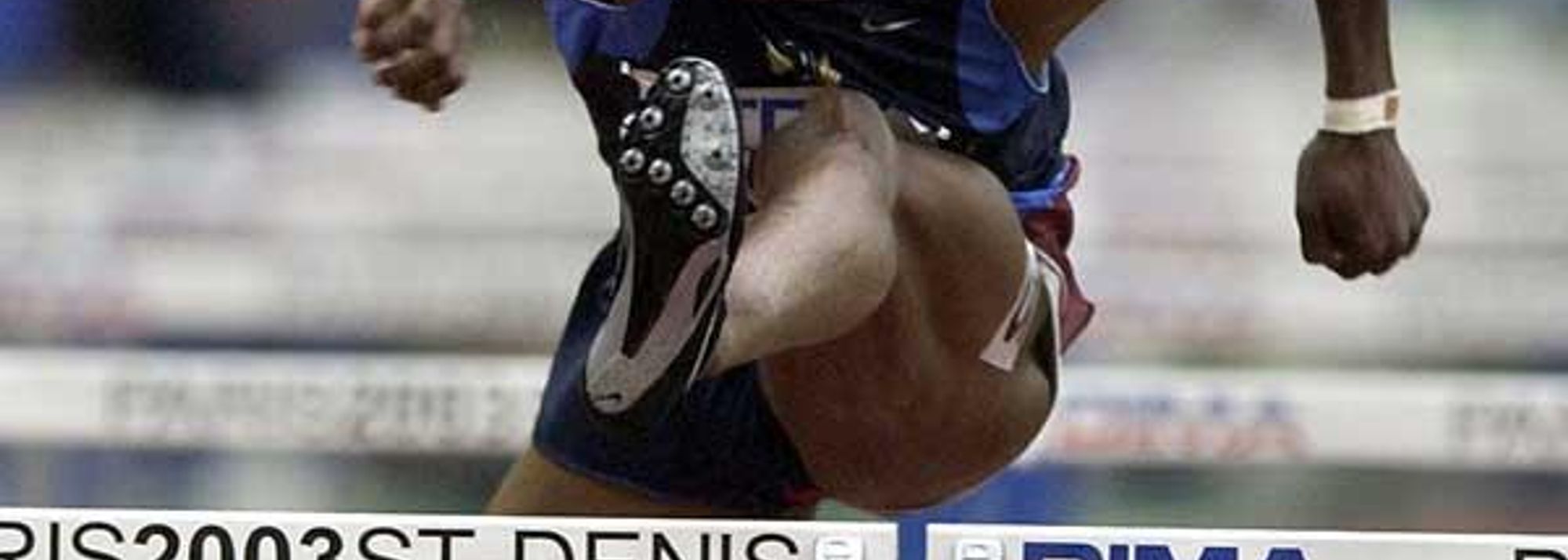Larry Wade (USA) at the 2003 World Championships (© Kirby Lee)
Los Angeles, USASo far, so good for Larry Wade in 2004.
After suffering two serious setbacks off the track over the last three years, the American 110m high hurdler is hoping good fortune continues in his buildup for his first Olympic berth in the U.S. Trials in Sacramento in July.
In 2000, Wade missed a spot by two places in the U.S. Trials eight weeks after heart surgery to remove fluid from the organ which had been caused by an automobile accident. A scar across Wade’s chest remains as a reminder of his ordeal.
Last year, Wade finished fourth in the IAAF World Championships in Paris competing with a broken left arm suffered during a fall in his home.
“It taught me a lot about myself,” Wade said. “If I can overcome the adversities in my life and still compete relatively well then running after No. 1 position in the world when I am healthy should not be as difficult.’’
Wade displaying promise of 1999
Wade, who ran 13.01 in 1999 to move into sixth on the all-time U.S. performer list, has been making a push for a global ranking this season. Wade has posted 13.13 marks in running to victory in the Texas and Modesto Relays for his fastest times since 2001.
The 29-year-old Wade will receive a big test in the Prefontaine Classic in Eugene, Oregon on 19 June against HSI teammate Allen Johnson, the U.S leader at 13.08.
“I don't have a time that I am going after,” Wade said. “I just want to keep having fun and learn something new every race. For now, I am happy taking each win.”
Car accident dashes 2000 Olympic hopes
Wade, the 1998 NCAA indoor and outdoor high hurdle champion at Texas A & M had high aspirations for a Sydney Olympics berth after moving from Texas to Los Angeles to join HSI and train under coach John Smith in the autumn of 1998.
Those plans were curtailed when Wade was involved in automobile accident on Easter Sunday in 2000. Wade totaled his Mustang convertible when he was sideswiped near his Canoga Park home while returning from a workout. He initially received 20 staples in his head thanks to an airbag deployment during the accident but further complications surfaced over the next two weeks.
First, he encountered a migraine headache that lasted more than a week. That was followed by a fever that reached 104 degrees, and what Wade called the worst symptom, chills combined with sweating.
When Wade awoke one morning with the left side of his body paralyzed, he was rushed to the hospital where doctors inserted a tube in his chest to remove fluid buildup in his heart.
Doctors told Wade that it would take two years to regain full strength. Nevertheless, Wade placed fifth in the U.S. Trials after a month layoff and five weeks of training.
The physical demands of the Trials, though, landed Wade back in the hospital after the meet. He experienced cramping and couldn’t complete workouts before the Trials.
“I was not concerned about running after the heart surgery because sometimes as athletes we believe that we are super human,” Wade said. “To be back in the hospital after running two races let know that it was dangerous and I was not human.”
Broken arm hinders 2003 campaign
Wade showed signs of recovery in 2002 when he won the USA Track & Field Indoor title and came third in the national outdoor championships. In 2003, however, Wade shattered his radial head and tore elbow ligaments in his left arm when he fell backward while standing on a box in his garage while reaching for an object.
Wade consulted compatriot hurdler Greg Foster, the former three-time World champion who competed in the 1988 U.S. Olympic Trials with a broken arm, and Mark Crear, who won a silver medal in the 1996 Olympics with a fractured arm, for advice.
“They both said it’s possible but it hurt like hell,” Wade said. “At that point it encouraged me because I felt like if they can do it then I could as well. It just motivated me and made stronger.”
Wade persevered to place third in the 2003 USATF championships, win the Pan-American Games title and place fourth in the World Championships.
Advancing to the final in Paris stunned even Wade, who still requires surgery to repair ligament damage in his arm but he has delayed it until the after 2004 season to avoid disruption to his Olympic buildup.
“I did not believe that I should have been in that World Championship final with the lack of training and the broken arm,” Wade said. “It let me know that as soon as I can be healthy enough to run a fun-filled season I will do great things.’’
Smith said Wade’s misfortunes were a humbling experience but has made Wade mentally stronger.
“You have to be patient,” Smith said. “It wasn’t his time. It was humility on both sides, him and I. We had to wait. He has grown up and has a better attitude about the sport itself. It’s really nice to be on this side after going through the whole gambit of everything.”
Star-studded training group
Wade doesn’t have to look far for inspiration training at UCLA under Smith with HSI teammates Maurice Greene, Ato Boldon, Mickey Grimes, Inger Miller, Torri Edwards and Angela Williams. He called the group his “extended family” and part of the foundation of his success.
“Everyone has there own identity and approach to running and life itself but I love and respect all of them,” Wade said. “With all the different personalities, it’s easy to relax and be yourself, which allows you to train better and perform better.”



